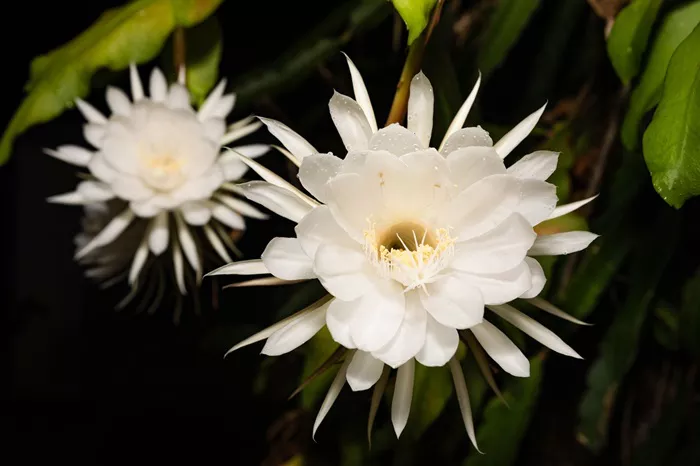Flowers have long enchanted us with their beauty and fragrance, but some plants reserve their most spectacular displays for the night. These nocturnal bloomers are not just a marvel of nature but also serve specific ecological purposes. In this article, we’ll explore ten flowers that bloom at night, each with its own unique charm and significance.
1. Moonflower (Ipomoea alba)
The moonflower is a striking species known for its large, white, trumpet-shaped blooms that unfurl in the evening. Native to tropical and subtropical regions, this flower opens its petals in the late afternoon and remains open through the night, releasing a delicate fragrance that attracts nocturnal pollinators like moths.
Characteristics:
Bloom Time: Evening to early morning
Fragrance: Sweet and subtle
Pollinators: Moths and other nocturnal insects
Moonflowers are often used in garden design to create a serene, moonlit atmosphere. Their striking appearance and enchanting scent make them a favorite for night gardens and moonlight strolls.
2. Night-Blooming Jasmine (Cestrum nocturnum)
Known for its intense fragrance, the night-blooming jasmine produces small, tubular white or yellowish-green flowers that open at night. The scent of these blooms can travel over long distances, attracting moths and other night-flying insects.
Characteristics:
Bloom Time: Late evening to early morning
Fragrance: Strong, sweet, and intoxicating
Pollinators: Moths, butterflies, and sometimes bats
This plant is often grown near patios or windows to enjoy its pleasant aroma during warm summer nights.
see also: Why Do I Love Jasmine So Much?
3. Evening Primrose (Oenothera biennis)
Evening primrose is a perennial known for its bright yellow flowers that open in the late afternoon and close by morning. These flowers have a subtle, sweet fragrance and are attractive to moths and beetles that are active at night.
Characteristics:
Bloom Time: Late afternoon to morning
Fragrance: Mildly sweet
Pollinators: Moths, beetles, and bees
The evening primrose is also valued for its medicinal properties and is used in herbal remedies for various conditions.
4. Nightshade (Solanum spp.)
While some nightshades are known for their toxic properties, certain species, like the purple-flowered Solanum, are notable for their night-blooming habits. These plants produce small, bell-shaped flowers that emit a faint but pleasant fragrance at dusk.
Characteristics:
Bloom Time: Dusk to early morning
Fragrance: Faint and pleasant
Pollinators: Moths and other nocturnal insects
The nightshade’s understated beauty and low-maintenance nature make it a great addition to night gardens.
5. Brugmansia (Brugmansia spp.)
Commonly known as angel’s trumpets, Brugmansia flowers are large, pendulous, and trumpet-shaped. They open in the evening and release a powerful, intoxicating fragrance that lingers through the night. These flowers are often found in tropical and subtropical gardens.
Characteristics:
Bloom Time: Evening to early morning
Fragrance: Strong and exotic
Pollinators: Moths and other night-flying insects
Brugmansia plants are dramatic and can be used to create a striking focal point in any night garden.
6. Datura (Datura spp.)
Datura, also known as moonflowers or devil’s trumpets, produce large, funnel-shaped blooms that open at dusk. These flowers can range in color from white to deep purple and have a distinctive, sweet fragrance that attracts night-flying insects.
Characteristics:
Bloom Time: Dusk to dawn
Fragrance: Sweet and musky
Pollinators: Moths and sometimes bats
Datura is often used in ornamental gardens due to its dramatic appearance and strong scent.
7. Night-Blooming Cereus (Cereus spp.)
The night-blooming cereus, also known as queen of the night, is a type of cactus that produces large, showy white flowers. These blooms typically open in the evening and last only one night, making their brief appearance all the more special.
Characteristics:
Bloom Time: Evening to early morning
Fragrance: Light and sweet
Pollinators: Moths and other nocturnal insects
This cactus is admired for its unique, ephemeral blooms and is often grown as a conversation piece in indoor gardens.
8. Four O’Clocks (Mirabilis jalapa)
Four o’clocks are named for their tendency to bloom in the late afternoon and evening. Their flowers come in a variety of colors, including pink, yellow, and white, and they emit a light fragrance that attracts night-flying insects.
Characteristics:
Bloom Time: Late afternoon to night
Fragrance: Light and pleasant
Pollinators: Moths and beetles
Four o’clocks are easy to grow and provide vibrant color to gardens that are enjoyed in the evening.
9. Nicotiana (Nicotiana spp.)
Nicotiana, or flowering tobacco, includes several species that bloom in the evening. These plants produce tubular flowers in shades of white, pink, or red, and their scent becomes more pronounced as night falls, drawing in moths and other pollinators.
Characteristics:
Bloom Time: Evening to morning
Fragrance: Strong and sweet
Pollinators: Moths, butterflies, and bees
Nicotiana is valued for its fragrant blooms and its ability to attract beneficial insects to the garden.
10. Ylang-Ylang (Cananga odorata)
Ylang-ylang is a tropical tree known for its fragrant, star-shaped flowers. These blooms open in the late afternoon and release a heady, sweet scent that is used in perfumes and aromatherapy. The flowers are yellow or greenish-yellow and are highly attractive to night-flying insects.
Characteristics:
Bloom Time: Late afternoon to night
Fragrance: Exotic and strong
Pollinators: Moths and other nocturnal insects
The ylang-ylang tree is often grown for its aromatic flowers and is a key component in many luxury perfumes.
Conclusion
Night-blooming flowers offer a unique charm, transforming gardens into mystical spaces as the sun sets. These plants are not just beautiful; they play crucial roles in their ecosystems, providing essential resources for nocturnal pollinators. By incorporating these flowers into your garden, you can enjoy a tapestry of color and fragrance that continues to captivate long after the sun goes down. From the elegant moonflower to the exotic ylang-ylang, each of these night-bloomers brings its own special allure, ensuring that the beauty of your garden is not limited to daylight hours. Embrace the magic of night-blooming flowers and create a garden that truly shines under the moonlight.
Related topics:
- Flowers to Plant in September for a Beautiful Spring
- Fall Planting Ensures Months of Continuous Spring Blooms
- The August Birthday Flower: A Detailed Exploration


